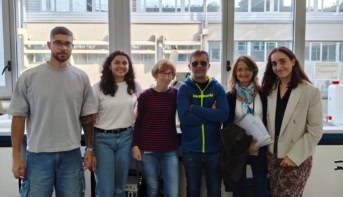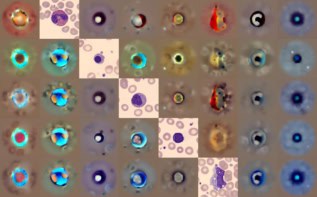
In contrast to the random motion of tiny objects placed in a bath of molecules at thermal equilibrium, miniature asymmetrically shaped cog wheels rotate continuously in one direction when exposed to swimming bacteria. That is the finding of a group of Italian scientists who built ratchets just a few hundredths of a millimetre across and filmed their motion when immersed in solutions containing E. coli. The researchers say that such bacteria-propelled ratchets could be used to power micro-machines or potentially even provide a new macroscopic source of energy.
Bacteria swim through fluids by using a number of rotary motors embedded in their cell walls to drive thin helically shaped filaments in a clockwise or anticlockwise direction. Researchers have used this motion to propel micro-structures but, as the bacteria movement is random, it is difficult to control without the addition of chemicals.
Now, Roberto Di Leonardo and colleagues at the University of Rome “La Sapienza” have shown how to exploit the motion of E. coli without controlling the bacteria in any way. They exploit the fact that a collection of bacteria immersed in a liquid represents a non-equilibrium thermodynamic system by virtue of the self-propulsion of the bacteria. This non-equilibrium system, they say, should confer ordered motion on an asymmetrically shaped object, in contrast to the random, Brownian motion, that thermal gas molecules would generate.
Using electron-beam lithography they etch out 10,000 saw-tooth gear wheels from the polymer SU8, each just 48 µm across and 10 µm thick (a volume equivalent to that of about 20,000 bacteria). They then dispersed the gear wheels in a suspension of E. coli, and hung a droplet of this liquid from the underside of a glass slide. This allowed the gear wheels to accumulate on the liquid-air interface, where they were held by capillary forces and free from the strong adhesion they would experience next to a solid surface.
The researchers observed that bacteria would strike the long-edge of each tooth and either bounce off or have their movement blocked by the next short-edge (see diagram). Given that bacteria do not stop swimming when they meet an obstacle or blockage, this caused them to push continuously against the short edge, with the combined motion of many such bacteria causing the gear wheel to rotate in one specific direction (clockwise in this case).
By filming the motion of the gear wheels, the researchers found that the gears rotated at a rate of about 1 revolution per minute, and that this value and variations in it caused by fluctuations in the number and arrangement of bacteria at the surface of the wheels closely matched the predictions of a computer simulation they carried out last year.
According to Di Leonardo, the performance of these bacteria-propelled ratchets could be improved tremendously. He notes that the linear velocity of the edge of the gears in their experiments is only about 2.5 µm per second whereas E. coli swim at about 20 µm per second. Getting closer to this second figure will, he says, involve experimenting with the shapes and sizes of the gear wheels as well as using other types of bacteria with different shapes and different swimming techniques.
Di Leonardo and his colleagues note in their paper that they can already foresee a completely new technology where “passive micro-devices can be fabricated and simply actuated by immersion in an active liquid”. Applications could include the powering of autonomous micrometre-sized machines that do not need to be powered by external electrical, magnetic or optical fields, as well as pumps or valves in microfluidic devices. This conversion of chemical energy into mechanical energy also suggests that the technology might be used as a power source, although Di Leonardo points out that the low-power density of a bacterial suspension – about 1 Wm–3 – makes this “very challenging”.
Howard Berg, a biophysicist at Harvard University in the US, says that the research is intriguing but not ultimately convincing. “If I were serious about this business, I would fabricate electromechanical propulsive devices out of silicon,” he says. “These are much more robust.”
This research is published on the arXiv preprint server.



